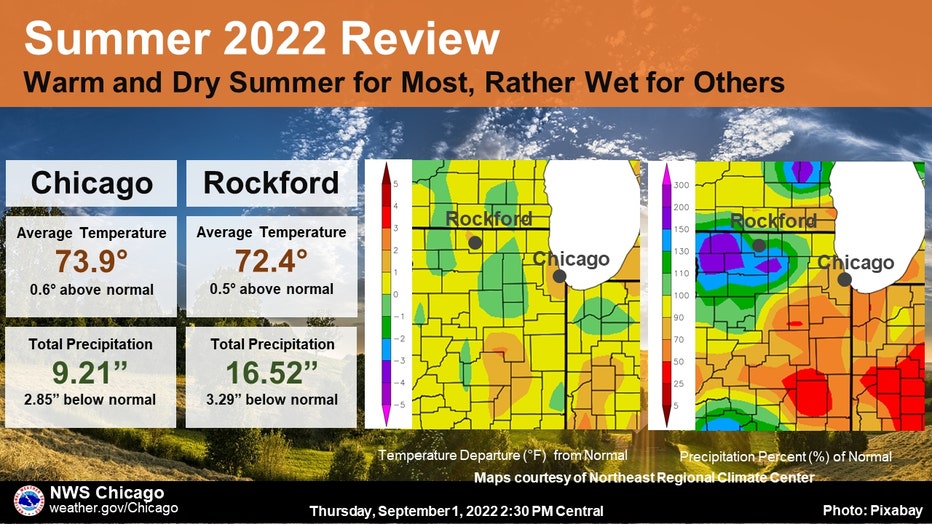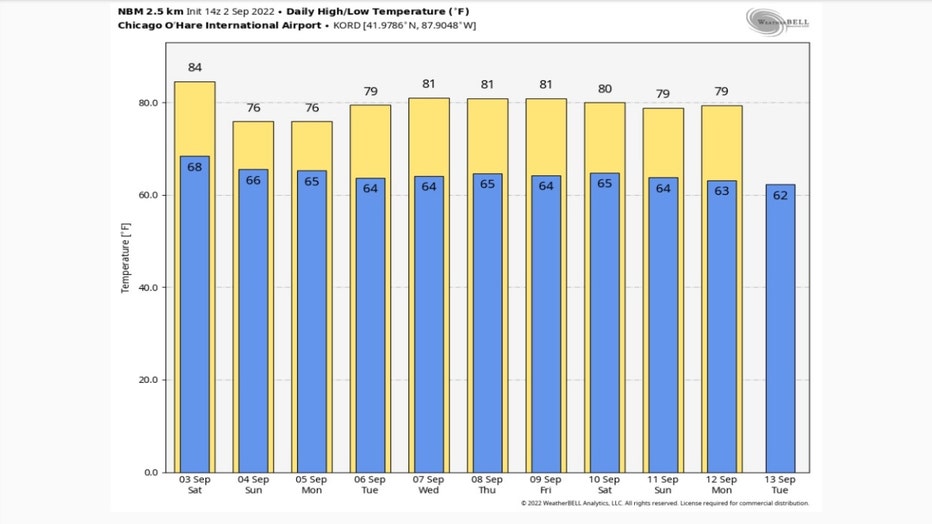Chicago's autumns are getting warmer
Chicago - Before I focus on fall, I want to summarize our summer.
It was Chicago's 25th warmest summer on record (25th warmest out of 148 summers). So far, meteorological fall is starting off warm. We ended up down nearly three inches of rain below average. So it ended up being a relatively warm and dry summer.
The forecast for fall keeps this pattern coming.
SUBSCRIBE TO THE FOX 32 YOUTUBE CHANNEL
It's just begun, but meteorological fall has started off warm. Thursday's high hit 88 degrees, or eight degrees above average. The forecast through at least the middle of the month favors a warmer than average pattern overall. More on that below.

Warm fall days is something we should be used to by now. Climate Central did a study of 245 U.S. cities to see how the number of warm fall days (days above average) has changed over the past 52 years. Nearly 80% of the cities they analyzed have gained at least seven additional fall days with above average temperatures compared to 1970. Eleven cities studied have gained an additional 30 above average fall days.
Chicago has seen an increase of eight more warm fall days over the period analyzed. Climate Central notes that "warmer fall temperatures raise risks of heat-related illness, insect-borne disease, allergies, and poor air quality".

Fall has been warming from coast-to-coast for the past 50-plus years. The average temperature for the season has jumped 2.7 degrees across the contiguous U.S. since 1970. 97% of the U.S. cities analyzed have warmed with 139 of those locations warming by 2 degrees or more. It's a nearly universal warm up with regions like the west, Midwest and Northeast seeing some of the biggest increases in temperatures.
The biggest jumps where found in Las Vegas (6.2 degrees), Tuscon (5.5 degrees) and Phoenix (5.3 degrees).

Chicago has seen a bump up too. Since 1970 our average temperature for fall has climbed 1.5 degrees.

A warmer fall has many impacts. Here are a few mentioned in Climate Central's report:
- When summer heat lingers into fall, it can extend the health risks posed by extreme heat and humid heat. Those most at risk for heat-related illness include children, older adults, people experiencing homelessness, outdoor workers, residents of low income communities, pregnant people, athletes, and others. When air conditioners are run later into the year to adapt, energy costs and heat-trapping emissions increase.
- A warming fall also contributes to a longer and more intense pollen season for the millions of Americans suffering with allergies and asthma. Hotter falls also mean a longer wildfire season. Since 1973, the number of fire weather days in the western U.S. has increased across all four seasons. Beyond the direct impacts on burned areas, wildfire smoke combined with heat-driven stagnant air can further worsen air quality posing additional risk to human health.
- Warming also allows disease-carrying insects such as mosquitoes and ticks to linger later into the fall. Fall warming can also disrupt the timing of ecologically important events like bird migrations, hibernation, and fruit ripening.
- Warmer temperatures during both spring and fall also extend the growing season—which can be beneficial for some agricultural crops but also for the pests that can reduce their yields. Warmer growing seasons can also increase the potential for water stress in plants, especially in drought-prone regions of the West and Southwest that have experienced the most fall warming.
It might not come as a surprise then that the forecast through the middle of the month is warmer than normal overall. The National Blend Of Models forecast calls for 7 of the next 10 days to hit highs above average. The average high for the start of this period is 80 degrees and then falls to 77 by the end of this stretch.

The Climate Prediction Center's 6-10 day and 8-14 day temperature outlooks keeps this warm pattern coming just past the middle of the month. The 6-10 day outlook has us "likely above" average from Sept. 7 through Sept. 11. That covers the period from next Wednesday through the following Sunday.

The 8-14 day outlook has us "leaning above" average from Sept. 9 through Sept. 15. That's the period from next Friday through the following Thursday.

Head to the lakefront if you want to try to stay cool. Oak Street Beach is the site of a beach volleyball tournament through Labor Day. Just avoid the water late Saturday through Sunday since strong winds will whip up big waves and dangerous rip currents.

